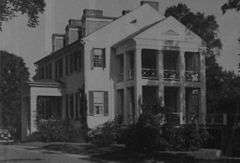Steuart family
The Steuart family of Maryland was a prominent political family in the early History of Maryland. Of Scottish descent, the Steuarts have their origins in Perthshire, Scotland. The family grew wealthy in the early 18th century under the patronage of the Calvert family, proprietors of the colony of Maryland, but would see their wealth and status much reduced during the American Revolution, and the American Civil War.
| Steuart | |
|---|---|
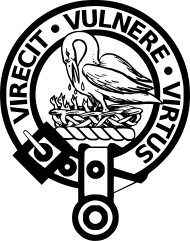 Steuart family crest | |
| Current region | Anne Arundel County, Maryland. |
| Earlier spellings | Stewart, Stuart. |
| Etymology | Stewards of Scotland |
| Place of origin | Perthshire, Scotland |
| Members | George H. Steuart (planter) (1700-1784) George H. Steuart (militia general) (1790-1867) George H. Steuart (brigadier general) (1828-1903) Richard Sprigg Steuart (1797-1876) |
| Connected families | Calvert family |
| Estate(s) | Dodon, Old Steuart Hall |
History
George Hume Steuart (1700–1784) was an Edinburgh-educated physician, who settled in Annapolis in the Province of Maryland in c1721, where he established a medical practice.[1][2] He married there, and became a tobacco planter, and politician.
Politically, Steuart's interests were closely aligned with those of the Calvert family, proprietors of the colony of Maryland.[3] In 1742 Charles Calvert, 5th Baron Baltimore (1699–1751) sent his eldest but illegitimate son, Benedict Swingate Calvert, then aged around ten years old,[4] to Annapolis and placed him in Steuart's care.[5] Steuart evidently benefited from the Calvert family's patronage, as he later was appointed to a number of important Colonial offices.
However, as a wealthy landowner with estates in both Maryland and Scotland, Steuart was forced by the outbreak of the American Revolution to decide whether to remain loyal to the British Crown or to throw in his lot with the American rebels. Unable to remain neutral, in 1775 he sailed to Scotland, where he lived until his death in 1784.[6] His sons however remained in Maryland, loyal to the fledgling United States of America.
Steuart's grandson, Major General George H Steuart (1790–1867) was a United States general who fought during the War of 1812. His military career began in 1814 when, as a young captain, he raised a company of Maryland volunteers, the Washington Blues, leading them at the Battle of Bladensberg and the Battle of North Point, where he was wounded.[7] After the war he rose to become major general of the Maryland Militia. In 1861, at the start of the Civil War, Steuart left his home state of Maryland, which stayed in the Union, and joined the Confederacy, though at 71 he was by then too old for active service.
During the American Civil War, Maryland remained loyal to the Union, but the Steuarts were substantial slaveholders and supported the Confederate States of America. On April 16, 1861 George H. "Maryland" Steuart, then an officer in the United States Army, resigned his captain's commission to join the Confederacy.[8] Much of the family's property was confiscated by the Federal government as a consequence of their participation in the Confederate Army. Old Steuart Hall was confiscated by the Union Army and Jarvis Hospital was erected on the estate, to care for Federal wounded.[9] The family's wealth and status never recovered from the catastrophe of the war.
A number of less well-known Steuarts also fought for the South. Among them was the surgeon William Frederick Steuart, and George Biscoe Steuart.[10]
Family tree
- George H. Steuart (planter) (1700–1784)
- George Steuart Hume (1747–1787), physician. Returned to Scotland to inherit the family estates in Perthshire.
- Dr Charles Steuart, physician (1750–1798)
- Dr Charles Steuart, physician (1784–1836)
- William Frederick Steuart (1816–1889), surgeon who served in the Army of the Confederate States of America during the Civil War
- George Biscoe Steuart (1817-1881) CSA
- George H. Steuart (physician) (1865-1945)
- George H. Steuart (diplomat) (1907–1998)
- George H. Steuart (physician) (1865-1945)
- Dr Charles Steuart, physician (1784–1836)
- William Steuart, wealthy planter (1754–1838)[11][12]
- Dr James Steuart of Annapolis (physician) (1755–1846). Baltimore Commissioner of Health in 1805 [13]
- George H. Steuart (militia general) (1790–1867), raised a company of volunteers and was wounded during the War of 1812.
- George H. Steuart (brigadier general) (1828–1903), fought for the Confederate States of America during the Civil War.
- Lieutenant William James Steuart (1832–1864), C.S.A. Killed at the Battle of the Wilderness, 1864.[14]
- Richard Sprigg Steuart (1797–1876), founder of the Maryland Hospital for the Insane, at Catonsville, Maryland.
- Dr James Aloysius Steuart (1828–1903). Baltimore Commissioner of Health from 1873-1882[15]
- George H. Steuart (militia general) (1790–1867), raised a company of volunteers and was wounded during the War of 1812.
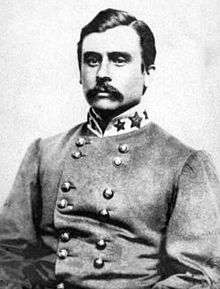 Brig. Gen. George H. "Maryland" Steuart
Brig. Gen. George H. "Maryland" Steuart William Steuart, planter
William Steuart, planter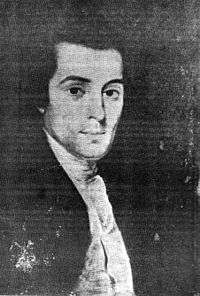 George Steuart Hume returned to Scotland to inherit his family estates
George Steuart Hume returned to Scotland to inherit his family estates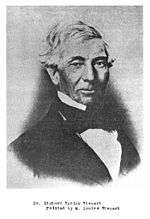 Richard Sprigg Steuart, founded the Maryland Hospital for the Insane
Richard Sprigg Steuart, founded the Maryland Hospital for the Insane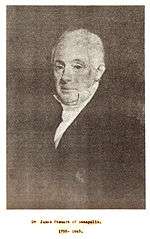 Dr James Steuart of Annapolis was a physician who served during the Revolutionary War
Dr James Steuart of Annapolis was a physician who served during the Revolutionary War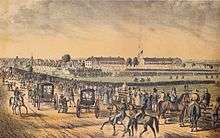 Major general George H. Steuart reviews his militia at Camp Frederick
Major general George H. Steuart reviews his militia at Camp Frederick William Frederick Steuart CSA, Surgeon to the 1st North Carolina Infantry
William Frederick Steuart CSA, Surgeon to the 1st North Carolina Infantry
Notable residences
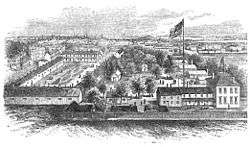
The Steuarts built a number of homes in Maryland, none of which have survived intact. Among them were:
- Maryland Square, a mansion on the outskirts of Baltimore, Maryland, owned by the Steuart family until 1861, when, at the beginning of the American Civil War, it was confiscated by the United States Federal Government. In 1862 Jarvis Hospital was constructed on the grounds of the Steuart estate, built for the care of wounded Union soldiers, the house itself being used as the hospital's headquarters.[17] The house was restored in 1866 to Brigadier General George H. Steuart after the war, but he never lived there again, choosing to live at Mount Steuart, his family estate on the Chesapeake in Anne Arundel County. The building was sold and became a school for boys, known as Steuart Hall, and in 1884 the mansion was demolished, to make way for the Grace Medical Center which stands there today.[18]
- Dodon, a 550-acre (2.2 km2) farm and former tobacco plantation in Maryland, located near the South River about 10 miles (16 km) south west of Annapolis. It is still home to the eighth generation of Steuarts today, who continue to farm, and to breed and race horses. Parts of the original house still remain, though most was destroyed in a fire c1950.[19]
Racing
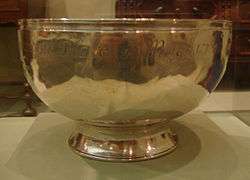
George H. Steuart (1700–1785), founder of the Steuart family in Maryland, was an enthusiastic horse breeder, and he instigated the Annapolis Subscription Plate, the name given both to the first recorded formal horse race in colonial Maryland and to the silver trophy awarded to the winner of the race. It is the second oldest known horse racing trophy in America.[20] The race was held in 1743 and was won by Steuart's horse, Dungannon.[21]
Modern Legacy
The unusual spelling of "Steuart" was widespread in the 18th century ("Steuart", "Stewart" and "Stuart" being essentially interchangeable), but has since mainly fallen into disuse. However, Steuart's numerous North American descendants have retained the archaic spelling.
A silver replica of the original Annapolis Subscription Plate was commissioned in 1955 by the Maryland Jockey Club. The "Dungannon Bowl" is a perpetual trophy presented to the winner of annual Dixie Stakes, the oldest stakes race run in Maryland and the Mid-Atlantic states.[22]
A stone obelisk at Dodon marks the burial place of Richard Sprigg Steuart and a number of other family members. Brigadier General George H. Steuart and his father Major General George H. Steuart are both buried beneath a family obelisk at Green Mount Cemetery, Baltimore,[23] and The Steuart Hill area of Baltimore recalls the family's long association with the city.[24]
See also
- Colonial families of Maryland
- Clan Stuart
Notes
- Papenfeuse, p.773
- American Swedish 1973, Edited by Leif Sjoberg, at p.69 Retrieved Jan 15 2010
- George H Stewart at Stewarts of Balquhidder webpage Retrieved Jan 15 2010
- Yentsch, Anne E, p.260, A Chesapeake Family and their Slaves: a Study in Historical Archaeology, Cambridge University Press (1994) Retrieved Jan 2010
- Eby, Jerrilynn, p.76, Laying the Hoe: a Century of Iron Manufacturing in Stafford County, Virginia, Vol 1, Heritage Books (2007). Retrieved Jan 19 2010
- Nelker, p.118
- Richardson, p.228
- Cullum, George Washington, p.226, Biographical Register of the Officers and Graduates of the U.S. Military Retrieved Jan 16 2010
- Nelker, p.120
- Hanson, George A., p.267, Old Kent: The Eastern Shore of Maryland Retrieved January 2012
- William Steuart at politicalgraveyard.com Retrieved Jan 19 2010
- Muller, Charles Geoffrey, p. 196, The darkest day: the Washington-Baltimore campaign during the war of 1812, Lippincott, (1963) Retrieved Jan 19 2010
- Quinan, John Russel, p.163, Medical Annals of Baltimore from 1608 to 1880, Baltimore (1884)
- Nelker, p.67
- Quinan, John Russel, p.163, Medical Annals of Baltimore from 1608 to 1880, Baltimore (1884)
- Nelker, p150
- Lossing, Benson John, p.605, Pictorial History of the Civil War in the United States of America, Volume 3 Retrieved Feb 6 2010
- Rice, p.290
- History of Dodon Farm Retrieved Feb 21 2010
- History of Maryland Jockey Club Archived 2011-05-25 at the Wayback Machine Retrieved Jan 21 2010
- Official History of the Maryland Jockey Club Retrieved February 18, 2010
- 126th Preakness Stakes Souvenir Magazine, May 19, 2001, article titled, "It All Began Here, In Annapolis..." page 95-96
- Greenmount Cemetery website Retrieved Jan 13 2010
- Steuart, William Calvert, Article in Sunday Sun Magazine, "The Steuart Hill Area's Colorful Past", Baltimore, February 10, 1963
References
- Goldsborough, W. W., The Maryland Line in the Confederate Army, Guggenheimer Weil & Co (1900), ISBN 0-913419-00-1.
- Hanson, George Adolphus, Old Kent: The Eastern Shore of Maryland: Notes Illustrative of the Most Ancient Records Of Kent County, Maryland (1876), unknown publisher.
- Nelker, Gladys P., The Clan Steuart, Genealogical Publishing (1970).
- Papenfuse, Edward C. et al., Archives of Maryland, Historical List, new series, Vol. 1. Annapolis, MD: Maryland State Archives (1990).
- Quinan, John Russel, Medical Annals of Baltimore from 1608 to 1880, Baltimore (1884)
- Rice, Laura, Maryland History in Prints 1743-1900, Maryland Historical Society, Baltimore (2002)
- Richardson. Hester Dorey, Side-Lights on Maryland History: With Sketches of Early Maryland Families (1913). ASIN: B00146BDXW, ISBN 0-8063-0296-8, ISBN 978-0-8063-0296-6.
- Steuart, George H., Letter to the National Intelligencer dated November 19, 1860, unpublished, Archive of the Maryland Historical Society.
- Steuart, William Calvert, Article in Sunday Sun Magazine, "The Steuart Hill Area's Colorful Past", Baltimore, February 10, 1963.
- White, Roger B, Article in The Maryland Gazette, "Steuart, Only Anne Arundel Rebel General", November 13, 1969.
External links
- Richardson, Hester Dorsey (1913). Side-lights on Maryland history: with sketches of early Maryland families. Vol. II. Williams and Wilkins. Retrieved Feb 21 2010
- Official Dodon website and history of the estate Retrieved Feb 21 2010
- article on Dodon farm at www.hometownannapolis.com Retrieved Feb 21 2010
